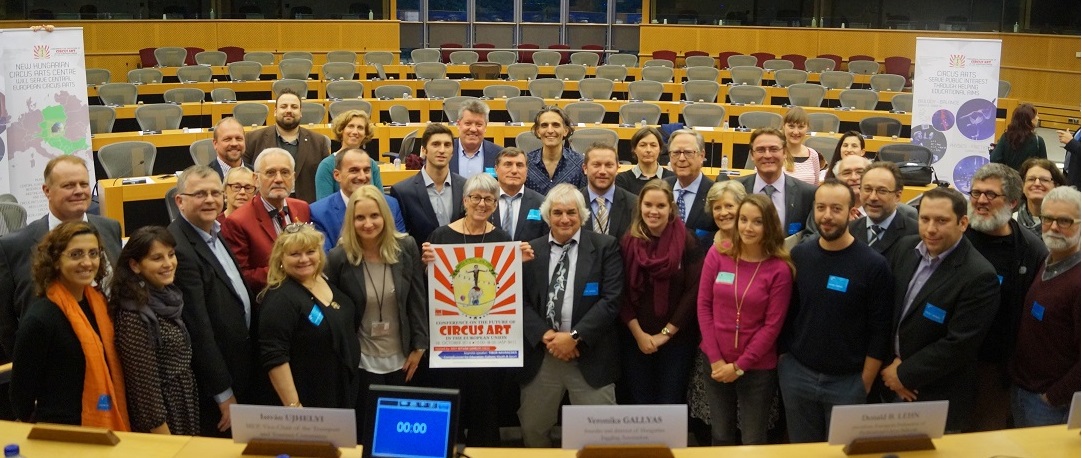“Under the Big Top” – Conference on the future of Circus Art in the European Parliament
(18. October 2016)
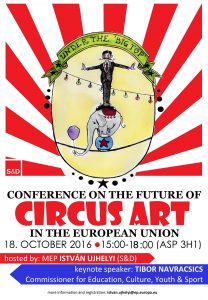 Circus art, in all its varieties is a valuable and remarkable part of the European culture. The traditional circus is a blend of organised artistic displays and musical entertainment in which acts featuring acrobats, clowns and domesticated and wild animals, are performed in the same ring in turn. In the past few decades modern new generation of entertaining circus performances started to run; the externalities, the visual world and the display of animals in the circus art has been changed, but not the function and not the outstanding cultural and economic value. Circus art is still one of the most influential artistic products, which plays a key role in the entertaining and tourism industry and gives a perfect evidence of cultural coexistence. To keep it this way, in Europe we need strategic thinking about traditional and new generation of circus art and we need wellcoordinated development.
Circus art, in all its varieties is a valuable and remarkable part of the European culture. The traditional circus is a blend of organised artistic displays and musical entertainment in which acts featuring acrobats, clowns and domesticated and wild animals, are performed in the same ring in turn. In the past few decades modern new generation of entertaining circus performances started to run; the externalities, the visual world and the display of animals in the circus art has been changed, but not the function and not the outstanding cultural and economic value. Circus art is still one of the most influential artistic products, which plays a key role in the entertaining and tourism industry and gives a perfect evidence of cultural coexistence. To keep it this way, in Europe we need strategic thinking about traditional and new generation of circus art and we need wellcoordinated development.
On the 18th of October, 2016 a historical conference was held in the European Parliament. The voice of circus people has never been heard before with respect this unique art deserves. István Ujhelyi, Hungarian member of the European Parliament – who
was the initiator and also the host of the event – wanted to bring closer the European decisionmakers and representatives of the traditional and the new generation of circus art to find out together: how we can preserve traditional circus values, how we can assist in the development of new artistic ways and strengthen the cultural cooperation between the circuses and their associated institutions. This article summarizes the presentations and comments in a chronological order.
ISTVÁN UJHELYI
Member of the European Parliament, Vice-President of TRAN-Committee:
 “The International Association of Circus Historians defined the term ‘circus’ in 1988 as ‘the meeting point between an organised artistic program and a musical company, with acts of acrobats, clowns and tamers of wild and domestic animals performing inside an oval-shaped esplanade’. To us, however, in this circle, it needs no proof; circus arts are so colourful it is hardly possible to define them with a single sentence.
“The International Association of Circus Historians defined the term ‘circus’ in 1988 as ‘the meeting point between an organised artistic program and a musical company, with acts of acrobats, clowns and tamers of wild and domestic animals performing inside an oval-shaped esplanade’. To us, however, in this circle, it needs no proof; circus arts are so colourful it is hardly possible to define them with a single sentence.
Circus is a form of art and culture with centuries-long history. Its significance stretches beyond pure entertainment; it bears intercultural, sociological and economic importance as well. To put simply, circus is a unique lifestyle. Circus, in all its varieties, is an integral and valuable part of our European culture. It is a great honour for me that so many of you have joined me today in order to discuss the current situation of circus arts, while it is imperative that we keep an eye on future opportunities and challenges. This is a defining moment as circus on its own right is a debutant topic in the European Parliament. I personally have profound respect for the art of circus. This is why I am extremely happy to embark on this journey with you and to represent your interests both here in Brussels and beyond.
Make no mistake, we have a lot to do. Unfortunately, we know very little, if anything, about the problems and demands of circus groups across Europe. The latest comprehensive study was conducted more than a decade ago.Ten years is a long time, circus has changed significantly since then. Besides traditional circuses, a modern wave of new generation circus spectacles has been gaining ground recently. These could take the form ofstreet performers, social circuses, youth circuses, or circus schools, but they have two things in common: they are all very close to my heart and are immensely valuable from a touristic point of view. The latter ones even play an especially important role fostering social cohesion and contributing to lowering youth unemployment as well, but we will come back to this a bit later.
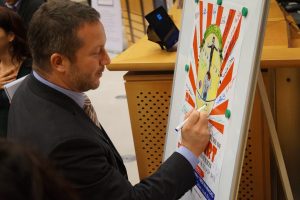 We barely talk about circus arts here in the European Parliament or in any European institution. We have the tendency to procrastinate answering certain questions. A concrete example is the issue of visa-concessions for traveling artists or artistes from third countries –a case I supported wholeheartedly as the rapporteur responsible in the TRAN committee. The visa package is now in the trialogue phase, we are progressing only slowly as the refugee crisis and the threat of terrorism both strengthen isolation instead of openness.In recent years, my colleagues have repeatedly submitted questions to the European Commission about animal welfare in circuses, calling for a general ban on displaying animals in circuses altogether. The Commission, however, made it very clear that this issue remains a national competence of member states, thus the Commission will not prohibit such performances. This is why animal performances are entirely banned in some states, while partially or fully allowed in others. Nevertheless, animal welfare cannot be swept under the carpet, we have to find the compromises that are satisfactory for all stakeholders, including the audience and animal rights organisations as well, whose worries are often legitimate.There is an obvious breakline between the worlds of traditional circuses and those animal-free new generation ensembles. My personal view remains that animal shows are an integral part of the circus art as we know it in Europe. At the same time, we must meet the demands of new generation circuses as well, ensuring the wellbeing of animals while respecting traditions and cultural values. This is why I hereby suggest the establishment of a special quality assurance system that could guarantee that both side’s concerns and priorities are fully respected.
We barely talk about circus arts here in the European Parliament or in any European institution. We have the tendency to procrastinate answering certain questions. A concrete example is the issue of visa-concessions for traveling artists or artistes from third countries –a case I supported wholeheartedly as the rapporteur responsible in the TRAN committee. The visa package is now in the trialogue phase, we are progressing only slowly as the refugee crisis and the threat of terrorism both strengthen isolation instead of openness.In recent years, my colleagues have repeatedly submitted questions to the European Commission about animal welfare in circuses, calling for a general ban on displaying animals in circuses altogether. The Commission, however, made it very clear that this issue remains a national competence of member states, thus the Commission will not prohibit such performances. This is why animal performances are entirely banned in some states, while partially or fully allowed in others. Nevertheless, animal welfare cannot be swept under the carpet, we have to find the compromises that are satisfactory for all stakeholders, including the audience and animal rights organisations as well, whose worries are often legitimate.There is an obvious breakline between the worlds of traditional circuses and those animal-free new generation ensembles. My personal view remains that animal shows are an integral part of the circus art as we know it in Europe. At the same time, we must meet the demands of new generation circuses as well, ensuring the wellbeing of animals while respecting traditions and cultural values. This is why I hereby suggest the establishment of a special quality assurance system that could guarantee that both side’s concerns and priorities are fully respected.
Circus arts do not only represent a cultural value. They play a crucial role in international cooperation, in strengthening intercultural diversity and social cohesion, in skills development for young people, and last but not the least, they help us think as a community. Circus arts are becoming an increasingly important driving force for the sustainable development of the tourism sector. As Vice-President of the TRAN committee responsible for tourism,this trend is something I can welcome and support genuinely.
There is far more to circuses than just spectacles and some oval stages ‘under the Big Top’. Today, I would like to put forward three initiatives regarding the future of circus arts. Your help and contribution will be vital to the success of our project. This is our common endeavour.
 My three proposals are as follows:
My three proposals are as follows:
First of all, I intend to officially call upon the Commission to prepare a new comprehensive study and analysis regarding the current needs, challenges, and problems that modern circuses face today in the European Union.
Second, I shall propose the establishment of a quality assurance and accreditation certificate that would rate ensembles on their traditional, cultural, and artistic value, with special attention on how they meetanimal wellbeingstandards.Let us call this certificate the “Big Top Label”, the Michelin star of circus arts, an independent quality assurance system guaranteeing quality circus art and no maltreatment of animals. I will send an official proposal concerning this issue to the International Organization for Standardization, but I am happy to initiate it individually as well, guided by your professional cooperation of course.
Finally, I would like to prepare a “Circus Manifesto” about the present situation and potential future challenges of circus art. This could be the guideline for European institutions and circus stakeholders alike.
My suggestion is that we prepare this manifesto together, with this very circle, or a similar but broadened one. I would like to kindly ask all of you here with us today to propose what we should include in our Manifesto so we can conclude on it in the near future.
My conclusion is the following: to me, representing all of you is a very sweet burden. If you like, I am now balancing on a tight rope between European institutions and representatives of circus arts.Thank you very much for coming, thank you for your attention. I will listen very carefully to all of your proposals.”
TIBOR NAVRACSICS
EU Commissioner for Education, Culture, Youth and Citizenship
 “(…) I’m in a very difficult position, because in my cabinet and in my services there are no vested interest of circus art and artists, which gives as the advantage of not having conflict of interest. But on the other hand it caused slightly helpless situation when we asked for background materials about circus art at European level. Because you may know that, every element of my portfolio belongs to the so called ‘principal of subsidiarity’, that means that just like education or sport, culture belongs to the exclusive competence of the member states. So circus art also belongs to the competence of the member states, however we know that if there is such kind of artist mobility at European level, so circus art is one of the most representative branch of the culture in the mobility of artist. Let me start with the creative cultural industry, just because partlyit belongs to my portfolio, however we are missing an overarchingstrategy or conception of culture and creative industry that European level. Why it’s quite clear that in a sharp competition among various regions of world economy that is one of the strongest point of Europeaneconomy is that we have rich tradition of economic activities, artistic activities based on our cultural heritage and circus art is part of that rich cultural heritage, because circus is ‘per definitionem’a European invention at least for us as we know it. I know that there are other traditionsof circus art as well, but for us this organic part of European culture can help overcoming economic difficult is as well.
“(…) I’m in a very difficult position, because in my cabinet and in my services there are no vested interest of circus art and artists, which gives as the advantage of not having conflict of interest. But on the other hand it caused slightly helpless situation when we asked for background materials about circus art at European level. Because you may know that, every element of my portfolio belongs to the so called ‘principal of subsidiarity’, that means that just like education or sport, culture belongs to the exclusive competence of the member states. So circus art also belongs to the competence of the member states, however we know that if there is such kind of artist mobility at European level, so circus art is one of the most representative branch of the culture in the mobility of artist. Let me start with the creative cultural industry, just because partlyit belongs to my portfolio, however we are missing an overarchingstrategy or conception of culture and creative industry that European level. Why it’s quite clear that in a sharp competition among various regions of world economy that is one of the strongest point of Europeaneconomy is that we have rich tradition of economic activities, artistic activities based on our cultural heritage and circus art is part of that rich cultural heritage, because circus is ‘per definitionem’a European invention at least for us as we know it. I know that there are other traditionsof circus art as well, but for us this organic part of European culture can help overcoming economic difficult is as well.
Ernst &Young – which you may know it’s an adviser company – made an analysisof the cultural and creative industries and it’s their data that performing arts, dance, theater, live music and circus arts provides 1,2 million jobs in European economies. Which means that, it can have and it actually has quite strong contribution to the European economic revival or the European economic growth. That’s why I think if we take cultural and creative industries as a whole, we have to elaborate a coherent conception of cultural and creative arts, where circus arts has its own place and regarding that circus art has at least two faces: one is supporting the maintenance and continuation of a great cultural tradition and on the other hand innovating that tradition with cutting edgetechnology performance and artistic achievements. We can build on both, as a strong element of future economic growth.
 We have a very good occasion for reinforcing our cooperation with the people of circus art and that is 2018, the European Year of Cultural Heritage. Which I think is an excellent opportunity not only for us, for the parliamentarians or members of the European Commission, but for you as well to show that our cultural heritages are treasures. It’s also a great opportunity to think about how we can contribute to economic revival, to cultural revival of Europe.How can we shape the circus art – and the definition of circus art – to built up a ‘European circus art’, I mean finding the meeting points, helping mobility of artists, making the circus art even more international (cosmopolitan or multinational as you wish), because I think circus art can show us good example how to add just national heritage and cosmopolitan approach in a good and an efficient way.So,that is why I would offer you a cooperation for developing new ideas for the European Year of Cultural Heritage in 2018. However, it is a European year, but almost all of the important initiatives must come from local, regional or member states level, because the Commission itself cannot organize a European, uniform something, which would be awfully boring, I think. So we would rely on your contribution to that and let’s think about it. And István mentioned the Commission’s responsibility to help you in establishing the artist mobility and he also mentioned that there is a trialogue on that issue. I hope, that we will find a good solution in the near future and a borderless Europe, a borderless EU, a more or less coherent Visa-policy for the EU member states will be available and will be present for you as well.So, I think that this event is only a kick-off meeting and I hope that we can work together in developing new ideas, conceptions, how to make the conception of cultural and creative industriesmore multicolored, more coherent and more complex, because I think that is thebest offer we can give to other regions of the world and we can prepare jointly for the European Year of the Cultural Heritage in 2018.
We have a very good occasion for reinforcing our cooperation with the people of circus art and that is 2018, the European Year of Cultural Heritage. Which I think is an excellent opportunity not only for us, for the parliamentarians or members of the European Commission, but for you as well to show that our cultural heritages are treasures. It’s also a great opportunity to think about how we can contribute to economic revival, to cultural revival of Europe.How can we shape the circus art – and the definition of circus art – to built up a ‘European circus art’, I mean finding the meeting points, helping mobility of artists, making the circus art even more international (cosmopolitan or multinational as you wish), because I think circus art can show us good example how to add just national heritage and cosmopolitan approach in a good and an efficient way.So,that is why I would offer you a cooperation for developing new ideas for the European Year of Cultural Heritage in 2018. However, it is a European year, but almost all of the important initiatives must come from local, regional or member states level, because the Commission itself cannot organize a European, uniform something, which would be awfully boring, I think. So we would rely on your contribution to that and let’s think about it. And István mentioned the Commission’s responsibility to help you in establishing the artist mobility and he also mentioned that there is a trialogue on that issue. I hope, that we will find a good solution in the near future and a borderless Europe, a borderless EU, a more or less coherent Visa-policy for the EU member states will be available and will be present for you as well.So, I think that this event is only a kick-off meeting and I hope that we can work together in developing new ideas, conceptions, how to make the conception of cultural and creative industriesmore multicolored, more coherent and more complex, because I think that is thebest offer we can give to other regions of the world and we can prepare jointly for the European Year of the Cultural Heritage in 2018.
At last but not to least, let me thank István for organizing this event. I think it is very good initiative. If we can, of course, we are going to help you in the future as well and help you as well as a special kind of communities of artists. Thank you.”
Roundtable discussion 1.:
Present and Future of Circus Art
PÉTER FEKETE,
Ministerial Commissioner for circus art in Hungary, director of Hungarian National State Circus
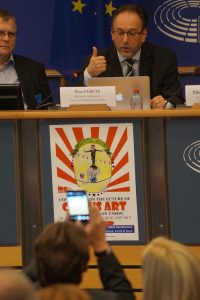 “(…) As you see on my label, I’m a ministerial commissioner for circus art. Which is a very funny thing, showing that Hungary takes circus art so seriously, that even announced a ministerial commissioner for circus art. It’s because we would like to built a new circus art centre in threeyears time, but before we build this new centre, we should know what we would like to do in this centre, why we doing that and how it will work. So, we are now in a research position, we brought with us five posters, which showing different subjects in which subjects we are very strangely and strongly looking for different answers; so during the conference please take the opportunity to read them and if you have questions, we can discuss them in the interval time. But I would like talk about the responsibility for keeping, securing, and renewing the circus art in Europe.
“(…) As you see on my label, I’m a ministerial commissioner for circus art. Which is a very funny thing, showing that Hungary takes circus art so seriously, that even announced a ministerial commissioner for circus art. It’s because we would like to built a new circus art centre in threeyears time, but before we build this new centre, we should know what we would like to do in this centre, why we doing that and how it will work. So, we are now in a research position, we brought with us five posters, which showing different subjects in which subjects we are very strangely and strongly looking for different answers; so during the conference please take the opportunity to read them and if you have questions, we can discuss them in the interval time. But I would like talk about the responsibility for keeping, securing, and renewing the circus art in Europe.
Classical circus: a way of renewing classical circus art could be to find a good content suitable for sending social messages. So, I think we can learn from new circus; if we would like to renew classical circus, we can spread social messages through classical circus.Let’s see what happened in the last 200 years. Circus has undergone an enormousdevelopment over the last 200 years. And not only the circus: theater, opera, modern and classical dance, everything has grown and changed in the last 200 years. In the beginning the circus was the place to present interesting and unusual natural qualities, skills and technical innovations. Butwhat was the reason for the major changes to the 200 years?First, technical development, because the circus is notlongera place where the latest technician wonders could appear. Second, television communication spread so sporting and other human achievements arrived to the people much easier way. Third, the social sensibility has increased enormously in society. Also the importance animal welfare grew in the society and developed other branches of performing art in the last century. So, what became as result of those profile cleaning. The first, that improving the human performances strong and more elaborate, more harmonic production with creator aesthetic impact arrived in the circus. Also the animal acts improved, because only harmonious men and animal pieces would be and can be shown in the circus. Also influence of other arts arrived: music, sound, lighting technology, even the video technology arrived to the circus. The situation today in one hand, is that the circus grown from being a part of entertainment industry, to an independent branch of performing art. Circus has became branch of the arts stretching the limit of human abilities and aesthetic elements able to send social messages. Circus now should be equal totheater, opera, dance, classical music and ballet. I believe, that they areequal. On the other hand we have some problems, because many people have turned away from the circus. Important classical circuses closed down in Europe and overseas recently. I just discussed with circus-friend people and they are afraid to go public places and lots of people not going to circus because they are afraid of terrorism. The circus is not attractive enough for the teenager generation. There is a lot to do for changing the feelings in people’s mind about circus. So, we have in one hand lot of achievements which give us responsibility and on the other hands we have warning signs which obligate us to rethink and checkthe possibilities for development. What are the area in which area we can do something? I think first time we have to make training stronger. Training in school level, artist training is school level, we should give master classes for children for traditional artist families. In the traditional artist families new generations are growing, and with time we have to give support for those children to bring them into school and give  extra lessons for them.And also we have to make sure that we train the backstage jobs, the professionals who serving the circus. So, all the backstage job we have to lift up with the training.We have to clean up the story with the animal acts. Only actssymbolizing harmony between human beings and animals should be performedin the circus. We going in this way, but we should clean up that situation. There is a big need for animal acts. In our circus in the Hungarian National State Circus, if we have phone calls from the audience, 80-85 percent of these calls are asking:what sort of animals do we have in the program.So, there is a big need for animal numbers in the circus. Demonstrating and strengthening social benefits, common cultural space for families and different generations – please think of it -, circus is the only art form and venue where all four generations going together: small kids, teenagers, parents and grandparents. The whole family visits one cultural space. We should keep this. Circus is a mediator for social messages. I believe that every circus art got social messages. Balance, respecting each other, trust, these are all questions which symbolize true circus acts. We should use them and we should spread these messages (…) Circus art is a carrier of messages of social responsibility. Circus is not nearly a private business anymore, but a communal, cultural and educational activity that should enjoy public support, accept founding from taxpayer’s money and receive social recognition. I believe in this.
extra lessons for them.And also we have to make sure that we train the backstage jobs, the professionals who serving the circus. So, all the backstage job we have to lift up with the training.We have to clean up the story with the animal acts. Only actssymbolizing harmony between human beings and animals should be performedin the circus. We going in this way, but we should clean up that situation. There is a big need for animal acts. In our circus in the Hungarian National State Circus, if we have phone calls from the audience, 80-85 percent of these calls are asking:what sort of animals do we have in the program.So, there is a big need for animal numbers in the circus. Demonstrating and strengthening social benefits, common cultural space for families and different generations – please think of it -, circus is the only art form and venue where all four generations going together: small kids, teenagers, parents and grandparents. The whole family visits one cultural space. We should keep this. Circus is a mediator for social messages. I believe that every circus art got social messages. Balance, respecting each other, trust, these are all questions which symbolize true circus acts. We should use them and we should spread these messages (…) Circus art is a carrier of messages of social responsibility. Circus is not nearly a private business anymore, but a communal, cultural and educational activity that should enjoy public support, accept founding from taxpayer’s money and receive social recognition. I believe in this.
So, Hungary is planning to build a new circus center. This will be a traditional circus building and a modern circus performance space with a museum of circus art, a Central-European researchcenter and data store, library, meeting rooms, indoor public spaces, and our circus art school and education center should be also is this place.And because we are in a very special situation in Central-Europe and the neighbor countries (Slovakia, Poland, Czech Republic, Austria, etc.) don’t have any circus center or stone-built circuses,so our center in Budapest aims to serve the European circus art.”
LACI ENDRÉSZ
circus-artist, director of Blackpool Tower Circus
 “(…) I come from many generations of Hungarian circus family, I live in the UK since 47 years, I’m a British citizen. I decided I believe today in here the idea to talk about the future of the circus future of the new generations. Instead of telling you what I think the future holds us, I would like to tell you a little story of my life – to tell what really the future of the circus is. When I was a young guyat 16, I used to practice many hours and I have no skin on my hands from the trapeze and have only one meal a day. I met an old circus artist Mr. Molnár and his wife, he was very respectful person, verywell respected artist he was. And he came to me and said: ‘circus is finished’. Pardon? – I replied. It was about 1961, and he told me: ‘no more future, circus has done’. I was 16 years old and I could very easily give in. ButI didn’t. I carried on, worked very hard and travelled the world. I did everything in circus, including training animals, tigers, elephants, horses, chimpanzees, kangaroos, I did trapeze, trampoline, and springboard. Eventually I had an impresario in London, which was quite successful and 25 years ago I’ve been asked to manage the tower circus of Blackpool. The rest is history. We have been running the Blackpool Tower Circus for the last 25 years. I just wanted to tell you when we are talking about the future of circus: how wrong Mr. Molnar was. There was future then and is future now. I have to tell you: I sleep, drink, eat circus. Circus is my religion. Circus is my passion and I’m very much looking forward to 2018 when our industry will be 250 years old.The origin of the circus comes from the UK,Philip Ashley created the first circus in 1768. Now, we will plan lot of celebrations and happenings in the UK for 2018. We hope we’ll create very good festivals and shows.
“(…) I come from many generations of Hungarian circus family, I live in the UK since 47 years, I’m a British citizen. I decided I believe today in here the idea to talk about the future of the circus future of the new generations. Instead of telling you what I think the future holds us, I would like to tell you a little story of my life – to tell what really the future of the circus is. When I was a young guyat 16, I used to practice many hours and I have no skin on my hands from the trapeze and have only one meal a day. I met an old circus artist Mr. Molnár and his wife, he was very respectful person, verywell respected artist he was. And he came to me and said: ‘circus is finished’. Pardon? – I replied. It was about 1961, and he told me: ‘no more future, circus has done’. I was 16 years old and I could very easily give in. ButI didn’t. I carried on, worked very hard and travelled the world. I did everything in circus, including training animals, tigers, elephants, horses, chimpanzees, kangaroos, I did trapeze, trampoline, and springboard. Eventually I had an impresario in London, which was quite successful and 25 years ago I’ve been asked to manage the tower circus of Blackpool. The rest is history. We have been running the Blackpool Tower Circus for the last 25 years. I just wanted to tell you when we are talking about the future of circus: how wrong Mr. Molnar was. There was future then and is future now. I have to tell you: I sleep, drink, eat circus. Circus is my religion. Circus is my passion and I’m very much looking forward to 2018 when our industry will be 250 years old.The origin of the circus comes from the UK,Philip Ashley created the first circus in 1768. Now, we will plan lot of celebrations and happenings in the UK for 2018. We hope we’ll create very good festivals and shows.
At least, I would like to tell you, what worries me sometimes. Sometimes peoplesay, that we are a ‘non-animal circus’. And the next one says, that we are ‘contemporary circus’, or someone says, that they are ‘real traditional circus with animals’. This worries me sometimes, because it divides us. Let just call us: ‘circus’. We are a big family, and this is our family-name. And let me announce the good news: we have no crisis in the circus! We have sometimes issues, sometimes problems, which should be dealt with. The circus is the most popular and most powerful entertainment form in this globe! And that is the very-very wonderful news, and we should be very happy about this.”
URS PILZ
President of Fédération Mondiale du Cirque
Artistic Director and the Vice-President of the Festival International du Cirque de Monte-Carlo
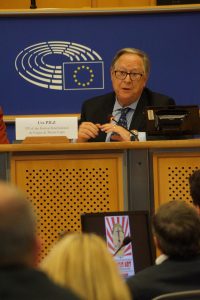 “(…) I’m very happy to have heard the words of Mr. Ujhelyi and Commissioner Navracsics, which are in many aspect very parallel to our thinking, to the thinking of organizations in the federation, but also as I know of the thinking of many circus peoples. So, we are having the same ideas, I speak specifically about the fact, that you are appreciate the quality, you ask for quality and you would be ready to give a certification for quality. That’s what circus needs. So, in the future, the good ones may survive, and the others must find solutions: either change or they will not be part of the future. That’s just my immediate reaction for what you said. With our federation, we support all forms of circus: circus in general, traditional circuses, new circuses including social circuses and circus schools. Of course, with the association and the federation we support traditional circus strongly, because we are on that field of traditional circus and that one is based on the three columns: acrobatics, comedy and animals. Prince Rainier of Monaco decided in 1974 to create a circus festival just based on these three columns, because he wanted to give support to the circus people. He left this business, he left the circus art and he saw that some of the circus families needed to be helped. And being Prince of Monaco he had good possibilities in doing something for the circus,as Monaco has great platforms for entertainment. Now this year we marked the 40 year anniversary of our festival, which still bases on the idea of Prince Rainier and also with the aim to give support to circus arts.
“(…) I’m very happy to have heard the words of Mr. Ujhelyi and Commissioner Navracsics, which are in many aspect very parallel to our thinking, to the thinking of organizations in the federation, but also as I know of the thinking of many circus peoples. So, we are having the same ideas, I speak specifically about the fact, that you are appreciate the quality, you ask for quality and you would be ready to give a certification for quality. That’s what circus needs. So, in the future, the good ones may survive, and the others must find solutions: either change or they will not be part of the future. That’s just my immediate reaction for what you said. With our federation, we support all forms of circus: circus in general, traditional circuses, new circuses including social circuses and circus schools. Of course, with the association and the federation we support traditional circus strongly, because we are on that field of traditional circus and that one is based on the three columns: acrobatics, comedy and animals. Prince Rainier of Monaco decided in 1974 to create a circus festival just based on these three columns, because he wanted to give support to the circus people. He left this business, he left the circus art and he saw that some of the circus families needed to be helped. And being Prince of Monaco he had good possibilities in doing something for the circus,as Monaco has great platforms for entertainment. Now this year we marked the 40 year anniversary of our festival, which still bases on the idea of Prince Rainier and also with the aim to give support to circus arts.
 The main thing was at this 40th festival, that we had the best of the best of the artist, we put them together in specific combined acts, this was the great thing thatChinese and Russian artist were working together in one show. The circus is really culture. Now, what do we want for the future?Just five points. The one is go further with the circus art of course. Second: to have a confirmation worldwide that circus is culture. Third: getting circus to be included into the inventory of UNESCO as intangible cultural heritage. Fourth: getting circus owners, circus producers, circus families and circus artists to continue they work within the respective laws and regulations withoutbeing attacked and without being exposed to false statements, to misleading information towards the public and towards politicians by animalists and organizations. In order that circus could fulfillits task also in the future for millions as the only life entertainment for the whole family.”
The main thing was at this 40th festival, that we had the best of the best of the artist, we put them together in specific combined acts, this was the great thing thatChinese and Russian artist were working together in one show. The circus is really culture. Now, what do we want for the future?Just five points. The one is go further with the circus art of course. Second: to have a confirmation worldwide that circus is culture. Third: getting circus to be included into the inventory of UNESCO as intangible cultural heritage. Fourth: getting circus owners, circus producers, circus families and circus artists to continue they work within the respective laws and regulations withoutbeing attacked and without being exposed to false statements, to misleading information towards the public and towards politicians by animalists and organizations. In order that circus could fulfillits task also in the future for millions as the only life entertainment for the whole family.”
HELMUT GROSSCURTH
managing director of European Circus Association
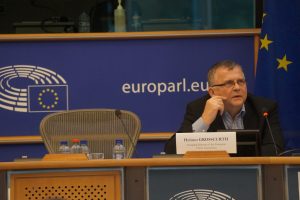 “(…) The ACE was founded in 2002 and the idea was following the idea of Prince Rainier in Monte Carlo: bring the circus word together, because together we are stronger and we can fight for the future of the circus. So, that’s what we tried to do in 2002. In the meantime we have more than one hundred member circuses around Europe, some associated members around the world. We try to promote circus culture in Europe. That is why I’m here and really happy to hear what you said. I can sign up to all the three initiatives, that you proposed. That’sexactly what we would like todo in Europe and with help we can do together (…) The majority of circuses in Europe now are touring circuses. We got still circus buildings, but the list is not too long (…) We have animal bans in several countries now in Europe, interestingly most of these countries never had a real circus scene. Or the circus scenes had gone down already. There is a total ban in Greece, but this country this time didn’t have any circus. So, most of these bans are something that politicians came up with to show that they are doing something (…) Thecircus scene is not equal in European countries.”
“(…) The ACE was founded in 2002 and the idea was following the idea of Prince Rainier in Monte Carlo: bring the circus word together, because together we are stronger and we can fight for the future of the circus. So, that’s what we tried to do in 2002. In the meantime we have more than one hundred member circuses around Europe, some associated members around the world. We try to promote circus culture in Europe. That is why I’m here and really happy to hear what you said. I can sign up to all the three initiatives, that you proposed. That’sexactly what we would like todo in Europe and with help we can do together (…) The majority of circuses in Europe now are touring circuses. We got still circus buildings, but the list is not too long (…) We have animal bans in several countries now in Europe, interestingly most of these countries never had a real circus scene. Or the circus scenes had gone down already. There is a total ban in Greece, but this country this time didn’t have any circus. So, most of these bans are something that politicians came up with to show that they are doing something (…) Thecircus scene is not equal in European countries.”
.
JR. JÓZSEF RICHTER
circus artist, director of Hungarian National Circus
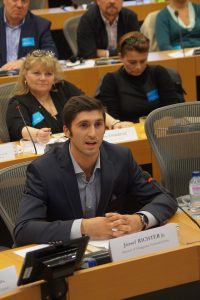 “(…) I come from an eight-generation circus family, already my parents and grandparents worked in the circus. I grew up with elephants and other animals. My father participated in the first Circus Festival in Monte Carlo, and has won the Silver Clown and later it was my brother who won the first Hungarian Gold Clown in Monte Carlo. To us this festival is just like the Olympics for the sportsmen. For us, the real traditional circuses are like the festival in Monte Carlo, or the Circus Krone in Germany, the Circus Knie in Switzerland. We also run a traditional circus with my family, and I think, thatin a traditional circus there always have to be animals, clowns and acrobats.If we take this out, peopledon’t get the circus atmosphere. If there is a change, then it is not the same. In Hungary, when the people are calling us, the first question is: what kind of animals do you have? The people want to see animals in the circus. In the last years, many videos appeared on the internet about bad circuses and bad circumstances, the animalist are speaking always in a bad way about circus art. The most important thing is to make difference between good and bad circuses. It’s the same when we got a dog at home. Some people are taking care of them well, some people are not. We’ve got the biggest travelling circus in Hungary and working very hard on it. We’ve got always open doors to anyone, if they want to see, how we live with our animals and how we train them. We also run a Facebook-group, called: ‘Circus, a place where animals can be also protected and kept good’, here we are posting updated pictures about our life every day. In many cities, where we are making a show, there aren’t any Zoos at all. So, for many children we gave the first experience with living animals as an open-door company.”
“(…) I come from an eight-generation circus family, already my parents and grandparents worked in the circus. I grew up with elephants and other animals. My father participated in the first Circus Festival in Monte Carlo, and has won the Silver Clown and later it was my brother who won the first Hungarian Gold Clown in Monte Carlo. To us this festival is just like the Olympics for the sportsmen. For us, the real traditional circuses are like the festival in Monte Carlo, or the Circus Krone in Germany, the Circus Knie in Switzerland. We also run a traditional circus with my family, and I think, thatin a traditional circus there always have to be animals, clowns and acrobats.If we take this out, peopledon’t get the circus atmosphere. If there is a change, then it is not the same. In Hungary, when the people are calling us, the first question is: what kind of animals do you have? The people want to see animals in the circus. In the last years, many videos appeared on the internet about bad circuses and bad circumstances, the animalist are speaking always in a bad way about circus art. The most important thing is to make difference between good and bad circuses. It’s the same when we got a dog at home. Some people are taking care of them well, some people are not. We’ve got the biggest travelling circus in Hungary and working very hard on it. We’ve got always open doors to anyone, if they want to see, how we live with our animals and how we train them. We also run a Facebook-group, called: ‘Circus, a place where animals can be also protected and kept good’, here we are posting updated pictures about our life every day. In many cities, where we are making a show, there aren’t any Zoos at all. So, for many children we gave the first experience with living animals as an open-door company.”
.
JULIE WARD
British member of the European Parliament, member of the CULT Committee:
 “I think it’s fantastic having this conference here in the Parliament because it helps to raise the profile of this old and noble profession. It’s quite clear that circus can form many different functions (…) Before I was a politician I worked in theatre and I came in to politics only to defend Europe. And now, my country is gonnabrexit, which is disastrous. We have to keep crossing all these borders and coming together, and I think culture, things like circus are going to be even more important. I’m a patron of an organization network, called the Independent Street Arts Network and they work very-very closely with lots of circus networks and performers. I also have a very personal connection: I have an adopted daughter and she is in her first year of circus school. She was a very lost child, a girl with quite tragic family circumstances and actually has found self-confidence and future in circus.I’m not sure what would have happened if she hadn’t found circus. So, I know how important it is. I’ve been submitting a proposal actually for a pilot-project ever since I arrived here about circus as a multifunctional tool. Because I’m trying to do, you know, Commission speak here. And I think that the fact that you’ve had the conference here today and the Commissioner was here, and we know now that we can work together on this and we have our networks here who can support us. I should share the proposal with you. I told to Tibor Navracsics that I’ve been sending this and keeps been rejected. But you were here today, he was here today, and I don’t think they could reject it anymore. So, I think we have to be cleverer and stronger now about how we used the fact that this conference happened here in this house today (…) Federica Mogherini, the High Representative announced a cultural diplomacy strategy. And that’s really an acknowledgement that in the world we live in, there is full of increasing xenophobia, fear, racism, division and hate. Culture is more important. And circus has to be part of that strategy. We have to make it clear that circus has an important role to play. It’s brilliant that you are doing this, thank you!”
“I think it’s fantastic having this conference here in the Parliament because it helps to raise the profile of this old and noble profession. It’s quite clear that circus can form many different functions (…) Before I was a politician I worked in theatre and I came in to politics only to defend Europe. And now, my country is gonnabrexit, which is disastrous. We have to keep crossing all these borders and coming together, and I think culture, things like circus are going to be even more important. I’m a patron of an organization network, called the Independent Street Arts Network and they work very-very closely with lots of circus networks and performers. I also have a very personal connection: I have an adopted daughter and she is in her first year of circus school. She was a very lost child, a girl with quite tragic family circumstances and actually has found self-confidence and future in circus.I’m not sure what would have happened if she hadn’t found circus. So, I know how important it is. I’ve been submitting a proposal actually for a pilot-project ever since I arrived here about circus as a multifunctional tool. Because I’m trying to do, you know, Commission speak here. And I think that the fact that you’ve had the conference here today and the Commissioner was here, and we know now that we can work together on this and we have our networks here who can support us. I should share the proposal with you. I told to Tibor Navracsics that I’ve been sending this and keeps been rejected. But you were here today, he was here today, and I don’t think they could reject it anymore. So, I think we have to be cleverer and stronger now about how we used the fact that this conference happened here in this house today (…) Federica Mogherini, the High Representative announced a cultural diplomacy strategy. And that’s really an acknowledgement that in the world we live in, there is full of increasing xenophobia, fear, racism, division and hate. Culture is more important. And circus has to be part of that strategy. We have to make it clear that circus has an important role to play. It’s brilliant that you are doing this, thank you!”
GIORGIO ANDRIAN
national heritage expert, former UNESCO-consultant
 “(…) I had a long trip to get here and I’m tired, but I’m extremely happy for two reasons. Firstly, it’s personal. When I was a kid, my grandmother took me to the circus and told me: ‘Sit! Enjoy! This is art!’ I have never changed my mind. The second is a professional reason: I used to serve UNESCO as an international civil servant for about ten years and now I’m an associated expert of them. And I’m very happy to see the name of UNESCO and intangible cultural heritage being mentioned. Mr. Pilz, this has to be the next achievement of the circus award to be properly listed and I will help to tell you (…) What is important? UNESCO as a global role, as the only UN-agency with the clear mandate on culture and the Commission, and the Parliament are working even closer and closer.Culture, honestly speaking, is not yet that developed, but I could believe that circus would be an item to close the tight (…) What you mentioned before Mr. Pilz, about the national lists, these are the pre-conditions for achieving a supernatural description and this is what I would definitely recommend, and I would more than happy to help you in engineering: a multinational agreement, a multinational candidacy on circus art. I took the freedom before coming here to double-check that with my former colleagues in Paris, and there is no item yet in that list of representative intangible heritage about circus. And everyone would be more than happy at the international level to have that described. A multinational candidacy is more difficult to make, but not impossible (…) 2018 could be the year, if we start working now, to get the Committee approving the first ever candidacy of circus art.”
“(…) I had a long trip to get here and I’m tired, but I’m extremely happy for two reasons. Firstly, it’s personal. When I was a kid, my grandmother took me to the circus and told me: ‘Sit! Enjoy! This is art!’ I have never changed my mind. The second is a professional reason: I used to serve UNESCO as an international civil servant for about ten years and now I’m an associated expert of them. And I’m very happy to see the name of UNESCO and intangible cultural heritage being mentioned. Mr. Pilz, this has to be the next achievement of the circus award to be properly listed and I will help to tell you (…) What is important? UNESCO as a global role, as the only UN-agency with the clear mandate on culture and the Commission, and the Parliament are working even closer and closer.Culture, honestly speaking, is not yet that developed, but I could believe that circus would be an item to close the tight (…) What you mentioned before Mr. Pilz, about the national lists, these are the pre-conditions for achieving a supernatural description and this is what I would definitely recommend, and I would more than happy to help you in engineering: a multinational agreement, a multinational candidacy on circus art. I took the freedom before coming here to double-check that with my former colleagues in Paris, and there is no item yet in that list of representative intangible heritage about circus. And everyone would be more than happy at the international level to have that described. A multinational candidacy is more difficult to make, but not impossible (…) 2018 could be the year, if we start working now, to get the Committee approving the first ever candidacy of circus art.”
TIBOR EÖTVÖS
president of the Hungarian Trade Union of Circus Artists, founder of Eötvös Cirkusz
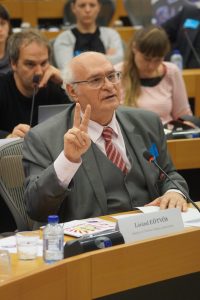 “(…) We have many questions about the circus in general and about new generation and traditional circuses. I was born in a circus wagon, and my family is one the most famous circus dynasties in Hungary. I go along with Jr. József Richter in that circuses needanimals. My opinion is that without animal acts, the circus is not really circus. I know for sure, that also the audience needs the animals in the show. I can tell you, that the members of the audience always have two questions to us: what kind of animals do you have, and how is the clown? It’s a great thing to be here and share our thoughts about the future of circus art. I would like to propose to adopt a document at the end about the traditional circuses with animal acts (…)”
“(…) We have many questions about the circus in general and about new generation and traditional circuses. I was born in a circus wagon, and my family is one the most famous circus dynasties in Hungary. I go along with Jr. József Richter in that circuses needanimals. My opinion is that without animal acts, the circus is not really circus. I know for sure, that also the audience needs the animals in the show. I can tell you, that the members of the audience always have two questions to us: what kind of animals do you have, and how is the clown? It’s a great thing to be here and share our thoughts about the future of circus art. I would like to propose to adopt a document at the end about the traditional circuses with animal acts (…)”
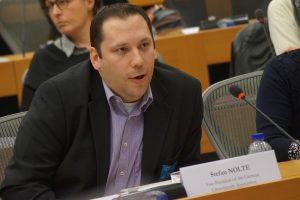 STEFAN NOLTE
STEFAN NOLTE
vice-president of the German Circus-friends Association
“(…) We’ve got about 200 members in Germany, in Austria, in Switzerland and also in the Netherlands. We aren’t professionals, but circus is also our life. We don’t just visit circuses, but we try to support them. We got our small group in Germany which tries to fight for animals in circus. I hope that we can support circus for a long time! Thanks for having me here today.”
Roundtable discussion 2.:
Social or Youth Circuses and professional education to Circus Arts:
training opportunities and fight against youth unemployment
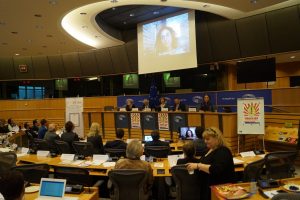 JILL MAGLIO
JILL MAGLIO
founder of Holistic Circus Therapy (videomessage)
“Dear István Ujhelyi, conference participants, colleagues and guests. I’m sorry not be with you today and parting the discussions, but I’d like to share with you some important work that’s been happening around circus arts in context of the refugee crisis. I work with the organization called CircusAid, we spent a month in ‘Calais-jungle’ this August, teaching circus to children and adults. We worked approximately 30 participants per day, mixed ethnic groups. What we’ve found, that people were playing together, they’ve found essence of joy, essence of hope and solidarity. And not promotes their overall mental health and well-being. When people are working together in circus activities for that temporary amount of time, they are not Syrian, not Iraqi, they are not victims. They are not ruminating about the past, they are not worrying about the future. They are just working together towards a common goal of throwing and catching things in the air. And that’s helping relieve a bit of mental anger they usually experienced from being in a camp. Please continue to support circus activities! Thanks for your time!”
 ELEFTERIOS KECHAGIOGLOU
ELEFTERIOS KECHAGIOGLOU
director of Plus Petit Cirque du Monde (Paris) & secretary of Caravan Network
„(…) We started our work in 1992 in a disadvantaged area, twenty kilometers from the centre of Paris. We do a lot of training for circus artists and social circus trainers, who want to use the circus as a media for social inclusion and for job development (…) In 2007 with Vincent Wauters from ‘Ecole de Cirque de Bruxelles’ and with other partners we founded Caravan Network, which is a working European network for social circuses. For that kind of associations who want to use circus as a tool for social inclusion and sustainable development of communities (…) Two years ago we started to build a new circus and we already finished it with a wooden big top of 28 meters. It’s a very low cost and sustainable building, because it’s 2000 square-meters, 360 seats and the cost was only 3.5 million Euros. We work on this field developing artistic, social and educational programs (…) Our team-members came from all around the world, because we believe that the circus could be a base for an international dialogue. Circus is an international language. Even if Philip Astley founded the European form of circus 250 years ago, the idea of acrobatics took place all around the world (…) Now, we are a third sector organization, working with private funds, public funds and own income. We do a lot of projects and social activities in our territory with the inhabitants and the young people in risk, alsoin prisons. We have circus at schools, we have  a comprehensive program with all the schools in our area (…) Circus today is not only circus for us. Our centre gives home also for urban arts and emerging culture, so we are also working with hip-hop, freerunning and parkour. We are preparing now a proposal for Creative Europe program with UK-partners in connection with the 250 years anniversary about how could we link this contemporary circus with dance, hip-hop and freerunning (…) We have also specific training programs and also developed a European training program with Caravan, called: ‘Circus Transformation’. It was founded by the European Commission and powered by Leonardo and Erasmus+ programs and it’s still running on (…) We have a strong cooperation with Cirque du Soleil, because in the last years they have developed a lot of social trainings and we do a lot of things with them. And of course we work together with professional artists, we are member of CircoStradaand try to make a strong link between professional artists and community circuses (…) There was a big project of Caravan: a research on social and youth circus pedagogy and we are ready to develop a European university degree on social circus. In our new program we are going to apply with University of Tampere for this with Erasmus+ in 2017.”
a comprehensive program with all the schools in our area (…) Circus today is not only circus for us. Our centre gives home also for urban arts and emerging culture, so we are also working with hip-hop, freerunning and parkour. We are preparing now a proposal for Creative Europe program with UK-partners in connection with the 250 years anniversary about how could we link this contemporary circus with dance, hip-hop and freerunning (…) We have also specific training programs and also developed a European training program with Caravan, called: ‘Circus Transformation’. It was founded by the European Commission and powered by Leonardo and Erasmus+ programs and it’s still running on (…) We have a strong cooperation with Cirque du Soleil, because in the last years they have developed a lot of social trainings and we do a lot of things with them. And of course we work together with professional artists, we are member of CircoStradaand try to make a strong link between professional artists and community circuses (…) There was a big project of Caravan: a research on social and youth circus pedagogy and we are ready to develop a European university degree on social circus. In our new program we are going to apply with University of Tampere for this with Erasmus+ in 2017.”
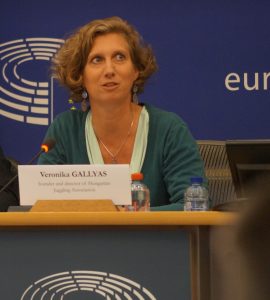 VERONIKA GALLYAS
VERONIKA GALLYAS
founder and director of Hungarian Juggling Association
„(…) I’m very proud to be a Hungarian at the moment, because this initiation comes from a Hungarian side. It’s very important for all of us, who passionate of circus art (…) I’m one of the first three hobby jugglers in Hungary, so I’m from a very different background. Earlier the people were not using juggling for hobby there was only the traditional circuses and the national circus school for that. In this year the miracle happened to us, that we could open the first circus space, what we called ‘Inspired Circus’ place. That’s the ‘physical body’ of the Hungarian Juggling Association (…) The main thing is to bring the new forms of circus to Hungary, because when we travelled at the end of the ’90s and the beginning of 2000, we visited new spaces in Europe and saw that the circus is really changed. We met very new forms than the traditional circus. We thought,this is something, what we have to show in Hungary. We started to organize and give a space to these new forms. For the momentour activities are the same like the model at Plus Petit Cirque du Monde: we have the education side, artistic side and social circus side (…) We run also leisure circus classes, so circus is for everybody. I believe in that, even housewives want to be in shape; they can come to hula hoop lessons if they want (…) We really believe that circus on this side is an art. It is also important that the joy of circus can be enjoyed by so many other people, not only the circus artist (…) The side of the circus space gives the opportunity to independent circus artists to practice; there are also a room for exchange, and it’s important, because today’s circus is about exchange. Before that it was indeed a world of secrets, because our family tried to keep our secret tricks, but today it’s the world of sharing and spending time together (…) Social circus is really one of the very flourishing activities in the Hungarian Juggling Association (…) we study how to use social circus in prison. They can learn about confidence. I saw crying a prisoner, who never experienced confidence in his life, but during that session we gave (…) We have also special need classes and we have weakly four groups in Hungary for integration in different suburb area of Budapest and we have two groups in Eastern-Hungary mainly with Roma communities  (…)Just some words about financial numbers: it is very interesting, because I made a chart of our contribution, and the big yellowish-greenish part is the European contribution, because we live mainly on European projects. Which means that we usually don’t have money for our general cost, but we have money to realize dreams to the European projects, that is why very important to be here because I’m really on the side of the EU and I really feel the power of the European Union. And then of course there are volunteer work which is for a civil society is very important, that is the grey part on the chart, and the very small one is the Hungarian governmental contribution which is 3000 euro a year and we actually don’t really have accessible founding, only 40.000 euro, I think for the moment we can apply for in Hungary and we get a big part of it, that is nice.And the rest is the income of the leisure circus classes, which is very important for us. (…) I think a civil organization like ours can contribute a new audience to the Hungarian circus or in any other country to the circus generally, because we really teaching the circus to families. We get like very committed audience to circus and also we can be a potential preparatory place for education for example for National Hungary Circus School (…)Usually, the power of the civil society is very important, because the volunteer work can be realize in this kind of frame. Also we can show that circus is much more than ever; just think about social work, how we can use circus for behavior-problems or hyperactive problems (…) It would be nice, if we could build up a good relation with the Hungarian colleagues from traditional circusesand to think together, because we are stronger together. We need to find the cooperation, how traditional circus can cooperate together with new or social circus forms (…) I would generate the kind of debates or meetings like this one, I think it’s a very historical moment. I also think that for the moment beside Creative Europe there is practically no support for artistic programs, so that’s something very much needed. I would also encourage the national programs for artistic development, because (…) if we would have the possibility to develop our own model in our country, it would give bigger diversity to the circus (…) We see that the therapeutic aspect of the circus is very important (…) I think the next step also very interesting: on the Hungarian faculty of special need, the social circus is already a subject, so they learn it, because they want to use it in the therapy. It would be a moment, when we proof the results with scientific researches and numbers.”
(…)Just some words about financial numbers: it is very interesting, because I made a chart of our contribution, and the big yellowish-greenish part is the European contribution, because we live mainly on European projects. Which means that we usually don’t have money for our general cost, but we have money to realize dreams to the European projects, that is why very important to be here because I’m really on the side of the EU and I really feel the power of the European Union. And then of course there are volunteer work which is for a civil society is very important, that is the grey part on the chart, and the very small one is the Hungarian governmental contribution which is 3000 euro a year and we actually don’t really have accessible founding, only 40.000 euro, I think for the moment we can apply for in Hungary and we get a big part of it, that is nice.And the rest is the income of the leisure circus classes, which is very important for us. (…) I think a civil organization like ours can contribute a new audience to the Hungarian circus or in any other country to the circus generally, because we really teaching the circus to families. We get like very committed audience to circus and also we can be a potential preparatory place for education for example for National Hungary Circus School (…)Usually, the power of the civil society is very important, because the volunteer work can be realize in this kind of frame. Also we can show that circus is much more than ever; just think about social work, how we can use circus for behavior-problems or hyperactive problems (…) It would be nice, if we could build up a good relation with the Hungarian colleagues from traditional circusesand to think together, because we are stronger together. We need to find the cooperation, how traditional circus can cooperate together with new or social circus forms (…) I would generate the kind of debates or meetings like this one, I think it’s a very historical moment. I also think that for the moment beside Creative Europe there is practically no support for artistic programs, so that’s something very much needed. I would also encourage the national programs for artistic development, because (…) if we would have the possibility to develop our own model in our country, it would give bigger diversity to the circus (…) We see that the therapeutic aspect of the circus is very important (…) I think the next step also very interesting: on the Hungarian faculty of special need, the social circus is already a subject, so they learn it, because they want to use it in the therapy. It would be a moment, when we proof the results with scientific researches and numbers.”
DONALD B. LEHN
president of European Federation of Professional Circus Schools (FEDEC)
 “(…) We believe in circus schools and we believe that circus schools are a very educate way of preparing people to become circus professionals. We don’t say by any means, that this is the only way. We know, that circus artist traditionally have been formed within the family. They are notable circus performers, who are self-taught, those are all perfectly valid, passed to reach the circus profession. I’m from a small school, I’m directing a circus school in Madrid. Years ago our association acquired a space and started giving classes and one day we decided to start a professional programme. The first question we asked ourselves was: what is a professional programme? How many hours, what is the distribution, safety protocols, measures to be enforced, who are the teachers? I cannot emphasize enough our vision was a small emerging project to discover and join this knowledgeable and energetic community the FEDEC. We still have doubts, but we bring them to the table and discuss them without anybody taking dogmatic positions. We tried to develop strategies that answers our questions and helped us progress as circus education promoters. As we have heard from my colleagues this afternoon, there are different levels of circus education. Youth is a tool for developing. (…) Social circuses can help people on the margins of society to help them integrate. And there is the professional level of circus training to train young people who have decided to become professionals. The FEDEC is dedicated to this area. This doesn’t mean we aren’t connected with other circus initiatives, but we decided it was an easier way to devote ourselves to pertinent projects in one specific area. So we train professional circus performers. The FEDEC is a structured network of higher education and vocational circus schools established in 1998. When the FEDEC was created when I joined in the year 2000 there was the 12 of us, now there are almost 60 members. We have members in 26 countries. It is an international network based in Europe, but including schools from Canada, North and South America, Australia, etc. We are in a dialogue with new, emerging schools in Asia. Basic landscape: there are 4 different levels of circus schools.(….) The backbone of circus training is acrobatics and physical training, specialty trainings, etc. Performing arts: theatre, dance, etc. is also an essential part of circus training today. As a circus school our job is not only to
“(…) We believe in circus schools and we believe that circus schools are a very educate way of preparing people to become circus professionals. We don’t say by any means, that this is the only way. We know, that circus artist traditionally have been formed within the family. They are notable circus performers, who are self-taught, those are all perfectly valid, passed to reach the circus profession. I’m from a small school, I’m directing a circus school in Madrid. Years ago our association acquired a space and started giving classes and one day we decided to start a professional programme. The first question we asked ourselves was: what is a professional programme? How many hours, what is the distribution, safety protocols, measures to be enforced, who are the teachers? I cannot emphasize enough our vision was a small emerging project to discover and join this knowledgeable and energetic community the FEDEC. We still have doubts, but we bring them to the table and discuss them without anybody taking dogmatic positions. We tried to develop strategies that answers our questions and helped us progress as circus education promoters. As we have heard from my colleagues this afternoon, there are different levels of circus education. Youth is a tool for developing. (…) Social circuses can help people on the margins of society to help them integrate. And there is the professional level of circus training to train young people who have decided to become professionals. The FEDEC is dedicated to this area. This doesn’t mean we aren’t connected with other circus initiatives, but we decided it was an easier way to devote ourselves to pertinent projects in one specific area. So we train professional circus performers. The FEDEC is a structured network of higher education and vocational circus schools established in 1998. When the FEDEC was created when I joined in the year 2000 there was the 12 of us, now there are almost 60 members. We have members in 26 countries. It is an international network based in Europe, but including schools from Canada, North and South America, Australia, etc. We are in a dialogue with new, emerging schools in Asia. Basic landscape: there are 4 different levels of circus schools.(….) The backbone of circus training is acrobatics and physical training, specialty trainings, etc. Performing arts: theatre, dance, etc. is also an essential part of circus training today. As a circus school our job is not only to  format artists. Our job is to provide them with tools, give them a full toolbox and allow them to make their choices themselves. Our main goals: participating in the development and evolution of circus training, circus pedagogy and creation in the field of circus arts. At the same time we also try to develop a dialogue between participants of the circus education process and youth circuses so youngsters might choose to become circus professionals. Our main activities are to organise exchanges between the different levels of participants of the circus education in which we elaborate studies in a theoretical level but also engage in practical activities and share teaching strategies, also allowing our students to talk about the way they develop as circus artists. As a rule we try and develop physical traces of these activities such as publications. When we do a study on the relationshipbetween circus artists and the marketplace, we sit down and talk to employers, cabarets, small circuses and big circuses and Cirque du Soleil and ask them how the students from our schools are responding to your needs. We ask our alumni how our education serve you as a professional. Then we make our conclusions available on the FEDEC website. We do this process through workgroups. (…) we are doing an enormous work to improve the quality of circus education.”
format artists. Our job is to provide them with tools, give them a full toolbox and allow them to make their choices themselves. Our main goals: participating in the development and evolution of circus training, circus pedagogy and creation in the field of circus arts. At the same time we also try to develop a dialogue between participants of the circus education process and youth circuses so youngsters might choose to become circus professionals. Our main activities are to organise exchanges between the different levels of participants of the circus education in which we elaborate studies in a theoretical level but also engage in practical activities and share teaching strategies, also allowing our students to talk about the way they develop as circus artists. As a rule we try and develop physical traces of these activities such as publications. When we do a study on the relationshipbetween circus artists and the marketplace, we sit down and talk to employers, cabarets, small circuses and big circuses and Cirque du Soleil and ask them how the students from our schools are responding to your needs. We ask our alumni how our education serve you as a professional. Then we make our conclusions available on the FEDEC website. We do this process through workgroups. (…) we are doing an enormous work to improve the quality of circus education.”
ZSUZSANNA MATA
executive director of the Fédération Mondiale du Cirque
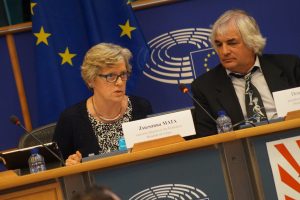 (…) Circus debuts in the EP for the first time on a conference, this is wonderful. Let me introduce the Federation Mondial de Cirque in the brief time given. Our organizations the first worldwide non-profit circus organization founded in 2008 in Monaco under the honorary presidency of Princess Stephanie, continuingthe work of her father Prince Rainier. The visionary idea came that the sector needs professional representation. Our organization includes only organizations, no individual circuses. (…) we have full and associate members, and other supporters as well. We are a big organization with he objectives to promote and preserve circus arts and culture, represent members and participate in circus related projects and provide professional support. Promotion for us first of all means that we promote circus arts for them to be accepted and respected part of culture. The European Parliament accepted in 2004 a resolution with one sentence saying that traditional circus with animals forms part of the European cultural heritage and culture. This is an indication for all European countries to think about the role of circus and to urge the national governments to accept circus as culture legally – as it happened in some states already. Our work include on international level the promotion of circus with the world digital library of which we are official partners of.We now have a lots of historical circus photos and images, documents put on the website which is open for everybody. Five years ago we started our UNESCO project that Giorgio has mentioned already with the aim for a multinational application to get circus art listed in the register of intangible cultural heritage. As a precondition the applicants already have to have circus art registered in their own national inventory. This is a very difficult and large procedure so until now only two countries have reached this: the Netherlands and Hungary. We created the World Circus Day seven years ago. This year more than 50 countries with 220 different circus events celebrated the date. Representation for us means serving the interests of circus community on all levels. We encourage the amendment of national legislations, we nominate circus ambassadors who hallmark the best ways in the circus industry and help in policy-making. We also take part in the preparation of legislation like when we had the chance to be the part of the working group for the traveling visa. We also offer professional, technical and legal support, we have a lot of professional collaborators, lawyers and scientists, veterinarians, biologists to help our work. We see a strategic partnership with any event which can make a positive influence on our sector, so we are always ready to cooperate. (…) Next steps: we have concrete projects for the future, the Federation is ready to collaborate with all organizations, we are happy to contribute to the future of the circus.
(…) Circus debuts in the EP for the first time on a conference, this is wonderful. Let me introduce the Federation Mondial de Cirque in the brief time given. Our organizations the first worldwide non-profit circus organization founded in 2008 in Monaco under the honorary presidency of Princess Stephanie, continuingthe work of her father Prince Rainier. The visionary idea came that the sector needs professional representation. Our organization includes only organizations, no individual circuses. (…) we have full and associate members, and other supporters as well. We are a big organization with he objectives to promote and preserve circus arts and culture, represent members and participate in circus related projects and provide professional support. Promotion for us first of all means that we promote circus arts for them to be accepted and respected part of culture. The European Parliament accepted in 2004 a resolution with one sentence saying that traditional circus with animals forms part of the European cultural heritage and culture. This is an indication for all European countries to think about the role of circus and to urge the national governments to accept circus as culture legally – as it happened in some states already. Our work include on international level the promotion of circus with the world digital library of which we are official partners of.We now have a lots of historical circus photos and images, documents put on the website which is open for everybody. Five years ago we started our UNESCO project that Giorgio has mentioned already with the aim for a multinational application to get circus art listed in the register of intangible cultural heritage. As a precondition the applicants already have to have circus art registered in their own national inventory. This is a very difficult and large procedure so until now only two countries have reached this: the Netherlands and Hungary. We created the World Circus Day seven years ago. This year more than 50 countries with 220 different circus events celebrated the date. Representation for us means serving the interests of circus community on all levels. We encourage the amendment of national legislations, we nominate circus ambassadors who hallmark the best ways in the circus industry and help in policy-making. We also take part in the preparation of legislation like when we had the chance to be the part of the working group for the traveling visa. We also offer professional, technical and legal support, we have a lot of professional collaborators, lawyers and scientists, veterinarians, biologists to help our work. We see a strategic partnership with any event which can make a positive influence on our sector, so we are always ready to cooperate. (…) Next steps: we have concrete projects for the future, the Federation is ready to collaborate with all organizations, we are happy to contribute to the future of the circus.
STÉPHANE SEGRETO-AGUILAR
Head of International Relations, Circostrada Network
 “I coordinate Circostrada, which is a European network for circus and street arts. We have about 90 members from 26 countries. It’s a European network, but we have also non-European members. Most of our members, about 99.9 percent of them are dealing with contemporary aesthetics.(…)I’m still trying to process all the information, especially information from the first roundtable, which is not new, but in a new perspective, since we are here in the European Parliament. I’m quite open to any kind of discussion with traditional circus organizations and networks. However, there are lots of differences – and I’m not even talking about aesthetics or values -, but I’m talking about economic models, issues and challenges, related to economic models. And I’m talking about audience engagement strategies, which are different. And I’m talking about recognition, when you think of a country like Germany, where a contemporary circus artist actually cannot apply for a grant, because his art form is not considered as an art form. When you think about Portugal, where you cannot apply for a residency, because actually the government only recognizes theatre, music and dance. There are some differences and I’m quite sure that we could find common points, there are many of us here, so we can work on that. Which leads for me on a second question: once we have common points, what we want to do together. I don’t have the answer of course, because this is the first meeting, but it is something that should be clearly addressed on the beginning and how can we do it.”
“I coordinate Circostrada, which is a European network for circus and street arts. We have about 90 members from 26 countries. It’s a European network, but we have also non-European members. Most of our members, about 99.9 percent of them are dealing with contemporary aesthetics.(…)I’m still trying to process all the information, especially information from the first roundtable, which is not new, but in a new perspective, since we are here in the European Parliament. I’m quite open to any kind of discussion with traditional circus organizations and networks. However, there are lots of differences – and I’m not even talking about aesthetics or values -, but I’m talking about economic models, issues and challenges, related to economic models. And I’m talking about audience engagement strategies, which are different. And I’m talking about recognition, when you think of a country like Germany, where a contemporary circus artist actually cannot apply for a grant, because his art form is not considered as an art form. When you think about Portugal, where you cannot apply for a residency, because actually the government only recognizes theatre, music and dance. There are some differences and I’m quite sure that we could find common points, there are many of us here, so we can work on that. Which leads for me on a second question: once we have common points, what we want to do together. I don’t have the answer of course, because this is the first meeting, but it is something that should be clearly addressed on the beginning and how can we do it.”
KOEN ALLARY
director of Circus Centrum, Gent
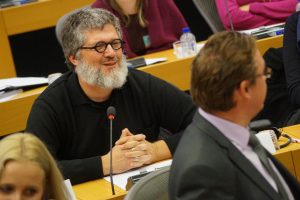 “(…) Firstly, this meeting is a great initiative, thank you. Secondly, it’s quite confronting how the same art form ‘circus’ has different universes: traditional, contemporary or social. But it’s one art form. With all my respect, we don’t need much more bla-bla from Europe, but boom-boom. And we have to work together around some common issues that can be the start of a very nice collaboration. For example: we need a European certificate for Big Tops. And that’s the same problem for contemporary or traditional circuses. In Europe today it’s quite shocking, that the Flemish circus was going to France, and afterwards to Germany, and it needed different certifications in each country. Europe must be Europe for the circuses and all the other art forms also. Another example: tax exemption for transport. If we say, circus is an art form, then we have to defend it. Then every circus transport is for free. Now, in Flanders there is tax for vans and trucks. We tried to negotiate with our minister about exemption, but his cabinet said: ‘oh no, it’s Europe; the EU asks to tax your transport!’ So, there are some common issues, that we can work immediately together, and that’s the way to find each other. Circus is about possibilities, and there are a lot of possibilities between us. For me, circus is not an act, it’s an attitude. We have all this attitude over here.”
“(…) Firstly, this meeting is a great initiative, thank you. Secondly, it’s quite confronting how the same art form ‘circus’ has different universes: traditional, contemporary or social. But it’s one art form. With all my respect, we don’t need much more bla-bla from Europe, but boom-boom. And we have to work together around some common issues that can be the start of a very nice collaboration. For example: we need a European certificate for Big Tops. And that’s the same problem for contemporary or traditional circuses. In Europe today it’s quite shocking, that the Flemish circus was going to France, and afterwards to Germany, and it needed different certifications in each country. Europe must be Europe for the circuses and all the other art forms also. Another example: tax exemption for transport. If we say, circus is an art form, then we have to defend it. Then every circus transport is for free. Now, in Flanders there is tax for vans and trucks. We tried to negotiate with our minister about exemption, but his cabinet said: ‘oh no, it’s Europe; the EU asks to tax your transport!’ So, there are some common issues, that we can work immediately together, and that’s the way to find each other. Circus is about possibilities, and there are a lot of possibilities between us. For me, circus is not an act, it’s an attitude. We have all this attitude over here.”
JOANNA CRISTINA FERREIRE FILIPE MARTINS
Circus School Chapitó
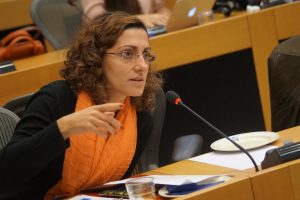 “(…) I’m from Portugal, the Chapitó, it’s a social circus school; we do an important work with students. It was very interesting to listen to EléfteriosKechiagioglou, because in Portugal we have the same project. And it was also good to hear Stéphane from Circostrada, we hope that we would have a great circus celebration in May. We are the only circus school in Portugal, and it’s not too easy to talk with the government or the ministry if we would like to achieve something. We do a very important work with students and young people from justice, but sadly nobody knows about it.”
“(…) I’m from Portugal, the Chapitó, it’s a social circus school; we do an important work with students. It was very interesting to listen to EléfteriosKechiagioglou, because in Portugal we have the same project. And it was also good to hear Stéphane from Circostrada, we hope that we would have a great circus celebration in May. We are the only circus school in Portugal, and it’s not too easy to talk with the government or the ministry if we would like to achieve something. We do a very important work with students and young people from justice, but sadly nobody knows about it.”
ALAIN TAILLARD
treasurer of European Youth Circus Organisation (EYCO) and manager of Fédérationfrançaise des écoles de cirque (FFEC)
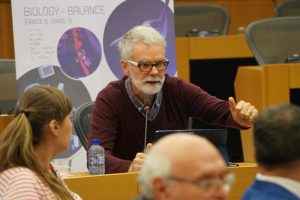 „(…) EYCO gathers today more than 11 network in Europe, which represents more than 500 youth circus schools. This organization was born in 2009 with only 5 members that time. We try to build a conception of a circus field, from the beginning till professional work. We try to build special links for example with FEDEC; we are going to have some meeting to find out how could we build a pathway between youth circus level to the professional artistic schools. We work also on the subject of possible degrees and official diplomas of this issue.”
„(…) EYCO gathers today more than 11 network in Europe, which represents more than 500 youth circus schools. This organization was born in 2009 with only 5 members that time. We try to build a conception of a circus field, from the beginning till professional work. We try to build special links for example with FEDEC; we are going to have some meeting to find out how could we build a pathway between youth circus level to the professional artistic schools. We work also on the subject of possible degrees and official diplomas of this issue.”
CHRISTIAN NOLENS
founder, owner, managing director of ‘On Stage Events – PRCom’
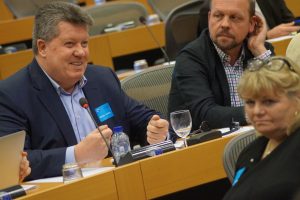 “(…) I’m not really a circus guy, I’m more than that. I’m obsessed by circus and everything that isrelated with any kind of circus. Maybe I would have some enemies, but I’m also involved in the animal cause. Of course we lost the battle here in Belgium, but we didn’t lose the war in Europe. I appreciate Mr. Ujhelyi’s statement at the beginning of this conference, where he also pointed particular aspect of animals. I agree with my Hungarian friends: there is a room for animals in the circus and I really appreciate your idea about a quality label. We have to make a difference between the serious institutions and the poor, the bad guys. But on the other hand I think the community of circus should be stronger against all those activists, who are very well organized, have a lot of income and support. Those independent circuses don’t have the tools to react. And when they react, they communicating not in the right way (…) Circus has to be united, ECA is doing it quite well, I’m trying to support circus, giving them information (…) What we are talking about? We have 150 elephants left in European circuses. They are well-kept, we respect those animals. I know that within 25 years, we won’t have any elephants in circuses. But what about that 39.000 elephants, which were brutally killed last year in Africa? Does somebody believe me, if it goes like this, than in 2053 there will be no more elephants left in Africa? What about the 27.000 lions, which has been killed last year in Africa? (…) What about that 29.000 dogs, cats and ponies, which are abandoned or mistreated? I’m telling it to you just to put it in a better and more honest context. I think, that language has to be used as well. That’s why I invite all circuses – have animals or not – to join forces. Because otherwise also the European battle will be lost.”
“(…) I’m not really a circus guy, I’m more than that. I’m obsessed by circus and everything that isrelated with any kind of circus. Maybe I would have some enemies, but I’m also involved in the animal cause. Of course we lost the battle here in Belgium, but we didn’t lose the war in Europe. I appreciate Mr. Ujhelyi’s statement at the beginning of this conference, where he also pointed particular aspect of animals. I agree with my Hungarian friends: there is a room for animals in the circus and I really appreciate your idea about a quality label. We have to make a difference between the serious institutions and the poor, the bad guys. But on the other hand I think the community of circus should be stronger against all those activists, who are very well organized, have a lot of income and support. Those independent circuses don’t have the tools to react. And when they react, they communicating not in the right way (…) Circus has to be united, ECA is doing it quite well, I’m trying to support circus, giving them information (…) What we are talking about? We have 150 elephants left in European circuses. They are well-kept, we respect those animals. I know that within 25 years, we won’t have any elephants in circuses. But what about that 39.000 elephants, which were brutally killed last year in Africa? Does somebody believe me, if it goes like this, than in 2053 there will be no more elephants left in Africa? What about the 27.000 lions, which has been killed last year in Africa? (…) What about that 29.000 dogs, cats and ponies, which are abandoned or mistreated? I’m telling it to you just to put it in a better and more honest context. I think, that language has to be used as well. That’s why I invite all circuses – have animals or not – to join forces. Because otherwise also the European battle will be lost.”
VINCENT WAUTERS
director of the Ecole de Cirque de Bruxelles
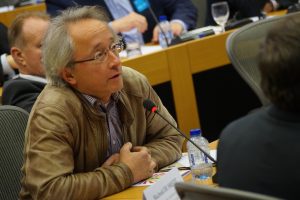 “(…) The circus is a wonderful world, with all the traditional circuses, contemporary circuses, with social circuses and with circus schools. I had a lot of different circus experience. I was juggler in the first two Cirque du Soleil, it was a wonderful experience. I was also working with animals which is wonderful, but you have to respect them. Circus is a wonderful world where we can experience a lot of different things.
“(…) The circus is a wonderful world, with all the traditional circuses, contemporary circuses, with social circuses and with circus schools. I had a lot of different circus experience. I was juggler in the first two Cirque du Soleil, it was a wonderful experience. I was also working with animals which is wonderful, but you have to respect them. Circus is a wonderful world where we can experience a lot of different things.
ANITA DEBAERE
director, Pearle – Performing Arts Employers’ Associations League Europe
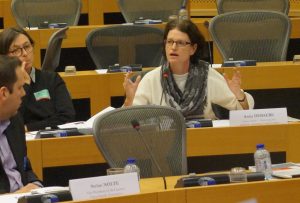 “(…) We have a special status in Europe, because we are recognized by the European Commission as an employers association. And we have a European social dialogue, where with trade union colleagues we work on a lot of topics: education, mobility, we work on health and safety issues (…) One of our main areas is on legal affairs. If there are issues you can bring up, we can be there to help you (…) It’s important to work on the recognition and your visibility.”
“(…) We have a special status in Europe, because we are recognized by the European Commission as an employers association. And we have a European social dialogue, where with trade union colleagues we work on a lot of topics: education, mobility, we work on health and safety issues (…) One of our main areas is on legal affairs. If there are issues you can bring up, we can be there to help you (…) It’s important to work on the recognition and your visibility.”
VIRGINIE JORTAY
Ecole Supérieure des Arts du Cirque / ESAC
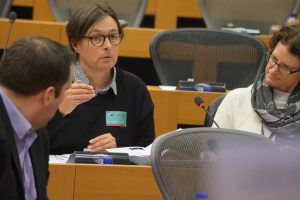 “(…) We are all concerned here by circus. But what kind of circus? It’s very difficult to answer. Helmut Grosscurth said something very important, I think. He said, that traditional circus and circus schools have nothing to do together, but they are two separate worlds. The main question for me is what we can do together. For me the question is to interrogate the needs. I have heard a lot of different things about needs today. Needs of animals, need of passport, need of something; but I think, that when we speak about needs, we have to think about the future. What kind of youth do you want to see? Do you want to see boys and girls treated like this or like this? Do you want to see human beings treating animals or being parts of animal beings? (…) I’m a bit concerned and afraid about the backlash, about traditional ideas of the way that women and men are treated on stage. I’m a bit concerned about men as humans treating animals on stage (…) You are socialist /pointing at MEP Ujhelyi/, I would trust you to be concerned first about relation between men and woman in the same way as we treat colonialism and also paternalism. It seems to me it is very important how these things are treated in circus.”
“(…) We are all concerned here by circus. But what kind of circus? It’s very difficult to answer. Helmut Grosscurth said something very important, I think. He said, that traditional circus and circus schools have nothing to do together, but they are two separate worlds. The main question for me is what we can do together. For me the question is to interrogate the needs. I have heard a lot of different things about needs today. Needs of animals, need of passport, need of something; but I think, that when we speak about needs, we have to think about the future. What kind of youth do you want to see? Do you want to see boys and girls treated like this or like this? Do you want to see human beings treating animals or being parts of animal beings? (…) I’m a bit concerned and afraid about the backlash, about traditional ideas of the way that women and men are treated on stage. I’m a bit concerned about men as humans treating animals on stage (…) You are socialist /pointing at MEP Ujhelyi/, I would trust you to be concerned first about relation between men and woman in the same way as we treat colonialism and also paternalism. It seems to me it is very important how these things are treated in circus.”
MARTIN BURTON
director of Zippos Circus and Chairman of the British Circus Proprietors Association (C.P.A.)
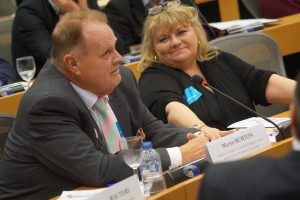 “(…) Those comments have been a long time coming in this meeting, and maybe they should have started, rather than finished there (…) We have two circuses: one with and one without animals (…) It is often considered, that circuses are sexist, animalist, racist, bla-bla. I have never in my life found that be the case on a classic circus. I want to give you one small example: I was in London with my circus and the local council sent a representative to talk to me about the number of disabled people that I employed. Because it’s necessary in my country to employ a percentage of disabled people. I said: I’m terribly sorry, but this is a circus, it’s very physical, we have no disabled people here. And that point adwarf walked past this lady. She said so he is disabled! My answer was: in my life I had never considered him other than another person. The circus at its heart is much less racist, sexist, animalist and everything else, than the rest of the world. Because when we work in the circus, we work with people who are equals. It’s often said, don’t tell me what you do, show me what you do in the ring, and I will respect for your work. I think it’s a huge mistake to allow this meeting to be dragged down to a point where we are worrying about political correctness. In an industry which has no need to worry about it…”
“(…) Those comments have been a long time coming in this meeting, and maybe they should have started, rather than finished there (…) We have two circuses: one with and one without animals (…) It is often considered, that circuses are sexist, animalist, racist, bla-bla. I have never in my life found that be the case on a classic circus. I want to give you one small example: I was in London with my circus and the local council sent a representative to talk to me about the number of disabled people that I employed. Because it’s necessary in my country to employ a percentage of disabled people. I said: I’m terribly sorry, but this is a circus, it’s very physical, we have no disabled people here. And that point adwarf walked past this lady. She said so he is disabled! My answer was: in my life I had never considered him other than another person. The circus at its heart is much less racist, sexist, animalist and everything else, than the rest of the world. Because when we work in the circus, we work with people who are equals. It’s often said, don’t tell me what you do, show me what you do in the ring, and I will respect for your work. I think it’s a huge mistake to allow this meeting to be dragged down to a point where we are worrying about political correctness. In an industry which has no need to worry about it…”




